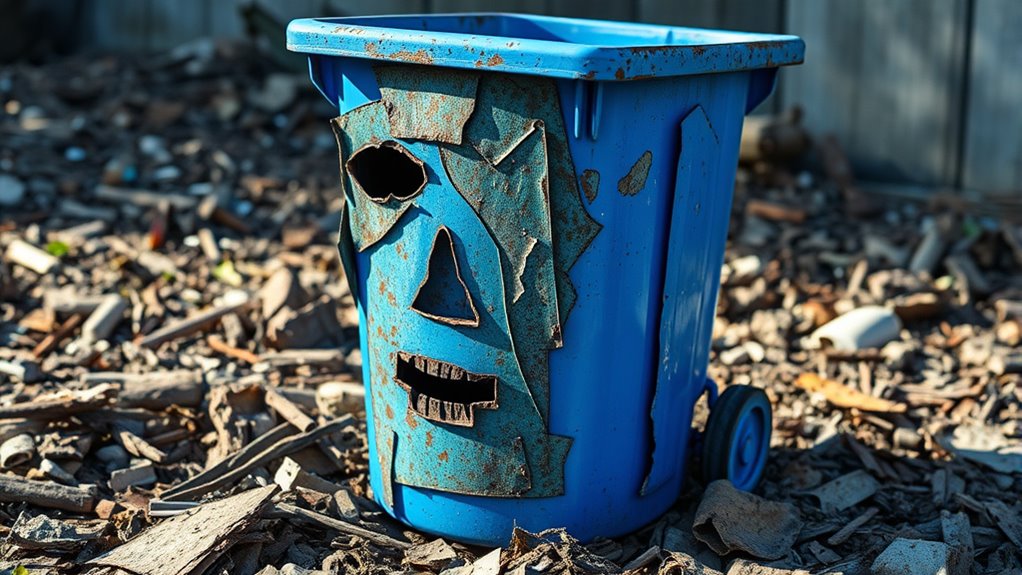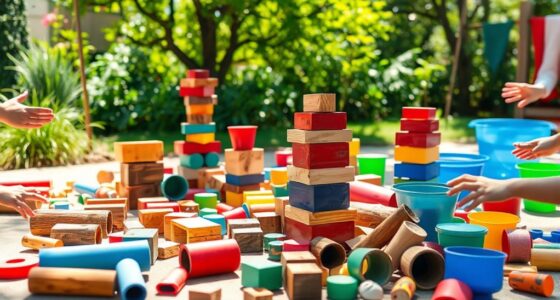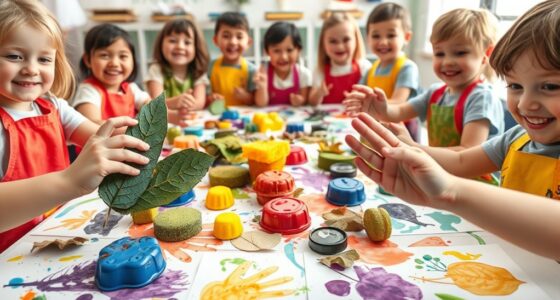Transform your recycling bin into inspiring art by creating found-object sculptures. Use everyday discarded items like bottle caps, broken toys, and scrap metal to craft meaningful pieces that celebrate recycling and sustainability. Get creative with techniques like gluing, welding, or stringing objects to build dynamic forms. This process not only helps reduce waste but also boosts your understanding of materials and design. Keep exploring to discover more ideas for turning trash into treasures.
Key Takeaways
- Transform everyday discarded items from your recycling bin into unique sculptures, emphasizing creative reuse and upcycling techniques.
- Collect objects like bottle caps, broken toys, or scrap metal to serve as building blocks for your artwork.
- Use simple tools such as glue, welders, or string to assemble and shape your found objects into artistic forms.
- Incorporate environmental themes to promote sustainability and encourage viewers to see waste as valuable raw materials.
- Explore creative problem-solving and experimentation to develop innovative sculptures that highlight recycling and reuse.

Found-object sculpture is an art form that transforms everyday discarded items into compelling works of creativity. When you plunge into this practice, you tap into a world where recycling techniques become your tools for artistic expression. Instead of tossing out what seems useless, you see potential in objects that others might overlook. By repurposing items like bottle caps, scrap metal, broken toys, or old utensils, you breathe new life into what was once considered trash. This approach isn’t just about saving waste; it’s about creating something unique and meaningful, making recycling part of your artistic journey.
As you explore found-object sculpture, you discover that your recycling bin isn’t just a container for waste—it’s a treasure chest filled with endless possibilities. You’ll find inspiration in the simplest objects: a bent wire, a plastic container, a worn-out shoe. Each item carries its own history and character, ready to be woven into a larger story through your hands. This process encourages you to see artistic inspiration everywhere, turning everyday objects into the building blocks of your artwork. It’s about noticing the beauty in the overlooked, transforming what seems mundane into something extraordinary.
Using recycling techniques in your sculpture practice means thinking creatively about how to combine and manipulate objects. You might weld metal scraps into a flowing form, glue broken ceramics into a mosaic, or string together plastic pieces into a dynamic mobile. These techniques challenge you to experiment and problem-solve, pushing your skills and imagination. The beauty of found-object sculpture is that it often doesn’t require traditional art supplies—your creativity and resourcefulness are enough. This eco-friendly approach not only reduces waste but also fosters a sense of innovation, encouraging you to see potential where others see debris.
This art form also offers a direct connection to environmental issues, making your work meaningful beyond aesthetics. Each sculpture becomes a statement about sustainability and reuse, prompting viewers to reconsider their own consumption habits. As you craft, you develop a deeper appreciation for the materials around you, seeing them not as discardable but as valuable raw material for artistic expression. Your sculptures can serve as conversation starters, inspiring others to rethink waste and embrace upcycling.
In addition, exploring upcycling techniques can enhance your understanding of how different materials behave and interact in your artwork. In the end, found-object sculpture is about more than just creating art; it’s about changing perspectives. By embracing recycling techniques and drawing inspiration from everyday objects, you turn your trash into treasures. You’ll find that your recycling bin becomes a source of endless artistic possibilities, inviting you to upcycle your environment and make a statement—one found object at a time.
Frequently Asked Questions
What Tools Are Best for Assembling Found-Object Sculptures?
You should use a hot glue gun or strong adhesive like epoxy for assembling your found-object sculpture, as they provide quick bonding and durability. Use assembly techniques such as layering, wiring, or wrapping to secure pieces firmly. Start by planning your design, then attach objects gradually, ensuring each piece is stable before moving on. These tools and techniques help you create a cohesive, long-lasting sculpture from recycled materials.
How Do I Ensure Stability in My Recycled Sculptures?
To guarantee stability in your recycled sculptures, focus on proper weight distribution by placing heavier objects at the base. Use structural reinforcement like glue, nails, or screws to securely bond pieces together, preventing wobbling or collapse. Balance your sculpture carefully as you assemble, and consider adding internal supports if needed. These steps help create a sturdy, durable piece that stays stable over time.
Can Children Safely Participate in Creating Found-Object Art?
Children can safely participate in creating found-object art when you carefully choose age-appropriate projects, like simple sculptures or colorful mosaics. Think of it as guiding a gentle hand through a garden; you must supervise and select materials suited to their age and skills. Ensuring child safety involves avoiding sharp edges, toxic paints, or small parts they might swallow. With proper supervision, kids can explore their creativity safely and joyfully.
What Are Some Eco-Friendly Sealing Options for Finished Sculptures?
You can choose eco-friendly sealing options like biodegradable adhesives or natural sealants to protect your sculpture. Biodegradable adhesives, such as plant-based glues, guarantee your artwork stays intact without harming the environment. Natural sealants like beeswax or plant oils provide a non-toxic finish that enhances durability and sustainability. These options allow you to seal your sculpture effectively while keeping your eco-conscious values intact, making your art both beautiful and environmentally friendly.
How Can I Display or Preserve My Upcycled Sculptures?
You can turn your upcycled sculptures into legendary masterpieces by expertly displaying and safeguarding them. Use clear acrylic cases for art preservation, showcasing their creative transformation while shielding them from dust and damage. Consider wall mounting or pedestal display for maximum impact. Apply protective coatings to prevent deterioration and ensure longevity. With these display techniques, your sculptures become timeless treasures that captivate viewers and stand the test of time.
Conclusion
Now that you’ve turned your recycling bin into a work of art, remember, every piece you upcycle is like planting a seed of creativity. Just like one person’s trash can become a treasured sculpture, your small efforts can inspire others to see beauty in reuse. Think of it as turning clutter into a community masterpiece—proof that with a little imagination, you can transform everyday objects into something extraordinary. Keep creating, and let your imagination run wild!









